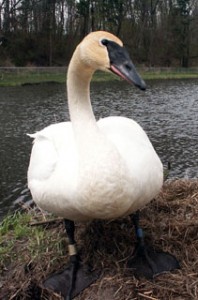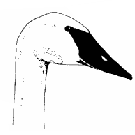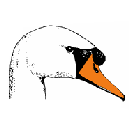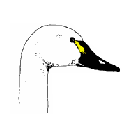What is a swan?
 Taxonomists (people who study how living things are related to each other) classify waterfowl based on the number of cervical vertebrae (neck bones) they have. Ducks have 16 or fewer neck vertebrae, geese have 17-23 neck vertebrae, and swan have 24 or more neck vertebrae.
Taxonomists (people who study how living things are related to each other) classify waterfowl based on the number of cervical vertebrae (neck bones) they have. Ducks have 16 or fewer neck vertebrae, geese have 17-23 neck vertebrae, and swan have 24 or more neck vertebrae.
The different length of neck allows many species of waterfowl to live together without competing with each other for food. Each kind of waterfowl can reach different types of food under water.
Which swan is which?
But how do you tell one swan from another? Just looking at the swan will tell you a lot. Most adult swan are white, but there are differences in the bills, shape of the head, size of the body and sound of their voice. Each species of swan have differently shaped trachea, which gives each species a different sounding voice. Tundra and Trumpeter swans are the only swans native to North America. Trumpeters and Tundras are similar looking species that can be more difficult to identify from each other. In various parts of the United States, however, there are significant populations of non-native Mute swans. Mute Swans are easily distinguished by the bright orange bill and distinctive knob on the forehead. Mute swans are considered an invasive species, which means that they may aggressively displace native Michigan bird species.
 |  |  |
| Trumpeter Swan | Mute Swan | Tundra Swan |
Voice
The vocal sound of a swan is determined by the shape of its trachea. The Trumpeter Swan has a long convoluted trachea, which allows sound to resonate. The Mute Swan has an almost straight trachea, and results in a soft voice which does not carry much distance
Trumpeter Swans have an unmistakable resonant, loud, trumpet-like call.
Mute Swans are generally silent but not “mute”. They have an assortment of grunts, snorts, and quiet whistles.
Tundra Swans have a high-pitched, often quavering oo-OO-oo call accentuated in the middle.
Posture
Trumpeters frequently have their neck kinked back at the base, forming an angular C-shape. The Tundra swan tends to hold it’s neck more vertically. Mute Swans generally hold their necks curved gracefully and bills pointed somewhat downward. Wings may be arched over the back giving a bulky appearance.
Trumpeter Swans tend to bob their head and neck up and down. This, when accompanied with vocalizations is a form of communication between individuals within a group and is more pronounced when the birds are disturbed. It reaches maximum intensity just prior to the birds taking flight. This behavior may be brief or absent if the birds are suddenly startled and take flight.
Tundra Swans do not bob their head and neck in this manner in such an exaggerated fashion, occasionally they will nod just their head up and down.
For More Information about Trumpeter Swans, please visit the National Park Systems page on Trumpeter Swan Facts, or check out the Trumpeter Swan Society on the web.

A legacy of conservation; a commitment to sustainability.
Kellogg Bird Sanctuary12685 East C Avenue
Augusta, MI 49012
Phone: (269) 671-2510 birdsanctuary@kbs.msu.edu